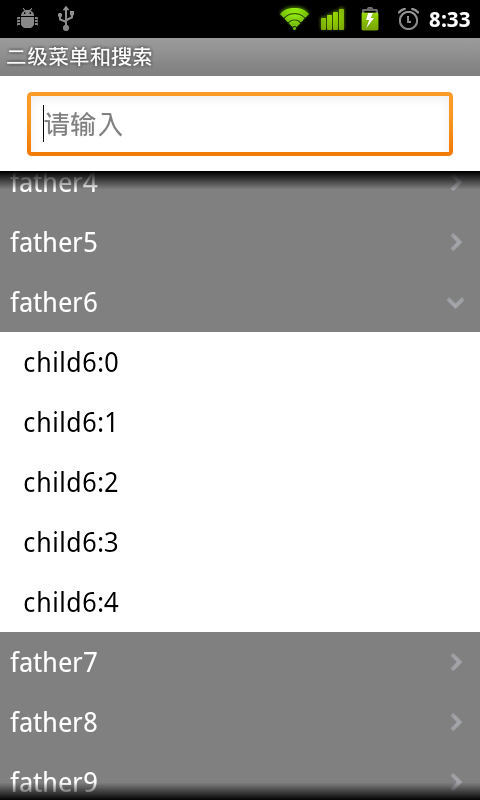編輯:Android開發實例
onInterceptTouchEvent()是ViewGroup的一個方法,目的是在系統向該ViewGroup及其各個childView觸發onTouchEvent()之前對相關事件進行一次攔截,Android這麼設計的想法也很好理解,由於ViewGroup會包含若干childView,因此需要能夠統一監控各種touch事件的機會,因此純粹的不能包含子view的控件是沒有這個方法的,如LinearLayout就有,TextView就沒有。
onInterceptTouchEvent()使用也很簡單,如果在ViewGroup裡覆寫了該方法,那麼就可以對各種touch事件加以攔截。但是如何攔截,是否所有的touch事件都需要攔截則是比較復雜的,touch事件在onInterceptTouchEvent()和onTouchEvent以及各個childView間的傳遞機制完全取決於onInterceptTouchEvent()和onTouchEvent()的返回值。並且,針對down事件處理的返回值直接影響到後續move和up事件的接收和傳遞。
關於返回值的問題,基本規則很清楚,如果return true,那麼表示該方法消費了此次事件,如果return false,那麼表示該方法並未處理完全,該事件仍然需要以某種方式傳遞下去繼續等待處理。
SDK給出的說明如下:
· You will receive the down event here.
· The down event will be handled either by a child of this view group, or given to your own onTouchEvent() method to handle; this means you should implement onTouchEvent() to return true, so you will continue to see the rest of the gesture (instead of looking for a parent view to handle it). Also, by returning true from onTouchEvent(), you will not receive any following events in onInterceptTouchEvent() and all touch processing must happen in onTouchEvent() like normal.
· For as long as you return false from this function, each following event (up to and including the final up) will be delivered first here and then to the target's onTouchEvent().
· If you return true from here, you will not receive any following events: the target view will receive the same event but with the action ACTION_CANCEL, and all further events will be delivered to your onTouchEvent() method and no longer appear here.
由於onInterceptTouchEvent()的機制比較復雜,上面的說明寫的也比較復雜,總結一下,基本的規則是:
1. down事件首先會傳遞到onInterceptTouchEvent()方法
2. 如果該ViewGroup的onInterceptTouchEvent()在接收到down事件處理完成之後return false,那麼後續的move, up等事件將繼續會先傳遞給該ViewGroup,之後才和down事件一樣傳遞給最終的目標view的onTouchEvent()處理。
3. 如果該ViewGroup的onInterceptTouchEvent()在接收到down事件處理完成之後return true,那麼後續的move, up等事件將不再傳遞給onInterceptTouchEvent(),而是和down事件一樣傳遞給該ViewGroup的onTouchEvent()處理,注意,目標view將接收不到任何事件。
4. 如果最終需要處理事件的view的onTouchEvent()返回了false,那麼該事件將被傳遞至其上一層次的view的onTouchEvent()處理。
5. 如果最終需要處理事件的view 的onTouchEvent()返回了true,那麼後續事件將可以繼續傳遞給該view的onTouchEvent()處理。
下面用一個簡單的實驗說明上述復雜的規則。視圖自底向上共3層,其中LayoutView1和LayoutView2就是LinearLayout, MyTextView就是TextView:
對應的xml布局文件如下:
<?xml version="1.0" encoding="utf-8"?>
<com.touchstudy.LayoutView1 xmlns:android="http://schemas.android.com/apk/res/android"
android:orientation="vertical"
android:layout_width="fill_parent"
android:layout_height="fill_parent" >
<com.touchstudy.LayoutView2
android:orientation="vertical"
android:layout_width="fill_parent"
android:layout_height="fill_parent"
android:gravity="center">
<com.touchstudy.MyTextView
android:layout_width="wrap_content"
android:layout_height="wrap_content"
android:id="@+id/tv"
android:text="AB"
android:textSize="40sp"
android:textStyle="bold"
android:background="#FFFFFF"
android:textColor="#0000FF"/>
</com.touchstudy.LayoutView2>
</com.touchstudy.LayoutView1>
下面看具體情況:
1. onInterceptTouchEvent()處理down事件均返回false,onTouchEvent()處理事件均返回true
------------------------------------------------------------------------------------------------------------------------------
04-11 03:58:42.620: DEBUG/LayoutView1(614): onInterceptTouchEvent action:ACTION_DOWN
04-11 03:58:42.620: DEBUG/LayoutView2(614): onInterceptTouchEvent action:ACTION_DOWN
04-11 03:58:42.620: DEBUG/MyTextView(614): onTouchEvent action:ACTION_DOWN
04-11 03:58:42.800: DEBUG/LayoutView1(614): onInterceptTouchEvent action:ACTION_MOVE
04-11 03:58:42.800: DEBUG/LayoutView2(614): onInterceptTouchEvent action:ACTION_MOVE
04-11 03:58:42.800: DEBUG/MyTextView(614): onTouchEvent action:ACTION_MOVE
…… //省略過多的ACTION_MOVE
04-11 03:58:43.130: DEBUG/LayoutView1(614): onInterceptTouchEvent action:ACTION_UP
04-11 03:58:43.130: DEBUG/LayoutView2(614): onInterceptTouchEvent action:ACTION_UP
04-11 03:58:43.150: DEBUG/MyTextView(614): onTouchEvent action:ACTION_UP
------------------------------------------------------------------------------------------------------------------------------
這是最常見的情況,onInterceptTouchEvent並沒有做任何改變事件傳遞時序的操作,效果上和沒有覆寫該方法是一樣的。可以看到,各種事件的傳遞本身是自底向上的,次序是:LayoutView1->LayoutView2->MyTextView。注意,在onInterceptTouchEvent均返回false時,LayoutView1和LayoutView2的onTouchEvent並不會收到事件,而是最終傳遞給了MyTextView。
2. LayoutView1的onInterceptTouchEvent()處理down事件返回true,
MyTextView的onTouchEvent()處理事件返回true
------------------------------------------------------------------------------------------------------------------------------
04-11 03:09:27.589: DEBUG/LayoutView1(446): onInterceptTouchEvent action:ACTION_DOWN
04-11 03:09:27.589: DEBUG/LayoutView1(446): onTouchEvent action:ACTION_DOWN
04-11 03:09:27.629: DEBUG/LayoutView1(446): onTouchEvent action:ACTION_MOVE
04-11 03:09:27.689: DEBUG/LayoutView1(446): onTouchEvent action:ACTION_MOVE
…… //省略過多的ACTION_MOVE
04-11 03:09:27.959: DEBUG/LayoutView1(446): onTouchEvent action:ACTION_UP
------------------------------------------------------------------------------------------------------------------------------
從Log可以看到,由於LayoutView1在攔截第一次down事件時return true,所以後續的事件(包括第一次的down)將由LayoutView1本身處理,事件不再傳遞下去。
3. LayoutView1,LayoutView2的onInterceptTouchEvent()處理down事件返回false,
MyTextView的onTouchEvent()處理事件返回false
LayoutView2的onTouchEvent()處理事件返回true
----------------------------------------------------------------------------------------------------------------------------
04-11 09:50:21.147: DEBUG/LayoutView1(301): onInterceptTouchEvent action:ACTION_DOWN
04-11 09:50:21.147: DEBUG/LayoutView2(301): onInterceptTouchEvent action:ACTION_DOWN
04-11 09:50:21.147: DEBUG/MyTextView(301): onTouchEvent action:ACTION_DOWN
04-11 09:50:21.147: DEBUG/LayoutView2(301): onTouchEvent action:ACTION_DOWN
04-11 09:50:21.176: DEBUG/LayoutView1(301): onInterceptTouchEvent action:ACTION_MOVE
04-11 09:50:21.176: DEBUG/LayoutView2(301): onTouchEvent action:ACTION_MOVE
04-11 09:50:21.206: DEBUG/LayoutView1(301): onInterceptTouchEvent action:ACTION_MOVE
04-11 09:50:21.217: DEBUG/LayoutView2(301): onTouchEvent action:ACTION_MOVE
…… //省略過多的ACTION_MOVE
04-11 09:50:21.486: DEBUG/LayoutView1(301): onInterceptTouchEvent action:ACTION_UP
04-11 09:50:21.486: DEBUG/LayoutView2(301): onTouchEvent action:ACTION_UP
----------------------------------------------------------------------------------------------------------------------------
可以看到,由於MyTextView在onTouchEvent()中return false,down事件被傳遞給其父view,即LayoutView2的onTouchEvent()方法處理,由於在LayoutView2的onTouchEvent()中return true,所以down事件傳遞並沒有上傳到LayoutView1。注意,後續的move和up事件均被傳遞給LayoutView2的onTouchEvent()處理,而沒有傳遞給MyTextView。
----------------------------------------------------------------------------------------------------------------
應大家的要求,我把源代碼貼上,其實很簡單,就是基礎文件,主要是用來觀察事件的傳遞。
主Activity: InterceptTouchStudyActivity.java:
public class InterceptTouchStudyActivity extends Activity {
static final String TAG = "ITSActivity";
TextView tv;
/** Called when the activity is first created. */
@Override
public void onCreate(Bundle savedInstanceState) {
super.onCreate(savedInstanceState);
setContentView(R.layout.layers_touch_pass_test);
}
}
LayoutView1.java:
public class LayoutView1 extends LinearLayout {
private final String TAG = "LayoutView1";
public LayoutView1(Context context, AttributeSet attrs) {
super(context, attrs);
Log.d(TAG,TAG);
}
@Override
public boolean onInterceptTouchEvent(MotionEvent ev) {
int action = ev.getAction();
switch(action){
case MotionEvent.ACTION_DOWN:
Log.d(TAG,"onInterceptTouchEvent action:ACTION_DOWN");
// return true;
break;
case MotionEvent.ACTION_MOVE:
Log.d(TAG,"onInterceptTouchEvent action:ACTION_MOVE");
break;
case MotionEvent.ACTION_UP:
Log.d(TAG,"onInterceptTouchEvent action:ACTION_UP");
break;
case MotionEvent.ACTION_CANCEL:
Log.d(TAG,"onInterceptTouchEvent action:ACTION_CANCEL");
break;
}
return false;
}
@Override
public boolean onTouchEvent(MotionEvent ev) {
int action = ev.getAction();
switch(action){
case MotionEvent.ACTION_DOWN:
Log.d(TAG,"onTouchEvent action:ACTION_DOWN");
break;
case MotionEvent.ACTION_MOVE:
Log.d(TAG,"onTouchEvent action:ACTION_MOVE");
break;
case MotionEvent.ACTION_UP:
Log.d(TAG,"onTouchEvent action:ACTION_UP");
break;
case MotionEvent.ACTION_CANCEL:
Log.d(TAG,"onTouchEvent action:ACTION_CANCEL");
break;
}
return true;
}
@Override
protected void onLayout(boolean changed, int l, int t, int r, int b) {
// TODO Auto-generated method stub
super.onLayout(changed, l, t, r, b);
}
@Override
protected void onMeasure(int widthMeasureSpec, int heightMeasureSpec) {
// TODO Auto-generated method stub
super.onMeasure(widthMeasureSpec, heightMeasureSpec);
}
}
LayoutView2.java:
public class LayoutView2 extends LinearLayout {
private final String TAG = "LayoutView2";
public LayoutView2(Context context, AttributeSet attrs) {
super(context, attrs);
Log.d(TAG,TAG);
}
@Override
public boolean onInterceptTouchEvent(MotionEvent ev) {
int action = ev.getAction();
switch(action){
case MotionEvent.ACTION_DOWN:
Log.d(TAG,"onInterceptTouchEvent action:ACTION_DOWN");
break;
case MotionEvent.ACTION_MOVE:
Log.d(TAG,"onInterceptTouchEvent action:ACTION_MOVE");
break;
case MotionEvent.ACTION_UP:
Log.d(TAG,"onInterceptTouchEvent action:ACTION_UP");
break;
case MotionEvent.ACTION_CANCEL:
Log.d(TAG,"onInterceptTouchEvent action:ACTION_CANCEL");
break;
}
return false;
}
@Override
public boolean onTouchEvent(MotionEvent ev) {
int action = ev.getAction();
switch(action){
case MotionEvent.ACTION_DOWN:
Log.d(TAG,"onTouchEvent action:ACTION_DOWN");
break;
case MotionEvent.ACTION_MOVE:
Log.d(TAG,"onTouchEvent action:ACTION_MOVE");
break;
case MotionEvent.ACTION_UP:
Log.d(TAG,"onTouchEvent action:ACTION_UP");
break;
case MotionEvent.ACTION_CANCEL:
Log.d(TAG,"onTouchEvent action:ACTION_CANCEL");
break;
}
return true;
}
}
MyTextView.java:
public class MyTextView extends TextView {
private final String TAG = "MyTextView";
public MyTextView(Context context, AttributeSet attrs) {
super(context, attrs);
Log.d(TAG,TAG);
}
@Override
public boolean onTouchEvent(MotionEvent ev) {
int action = ev.getAction();
switch(action){
case MotionEvent.ACTION_DOWN:
Log.d(TAG,"onTouchEvent action:ACTION_DOWN");
break;
case MotionEvent.ACTION_MOVE:
Log.d(TAG,"onTouchEvent action:ACTION_MOVE");
break;
case MotionEvent.ACTION_UP:
Log.d(TAG,"onTouchEvent action:ACTION_UP");
break;
case MotionEvent.ACTION_CANCEL:
Log.d(TAG,"onTouchEvent action:ACTION_CANCEL");
break;
}
return false;
}
public void onClick(View v) {
Log.d(TAG, "onClick");
}
public boolean onLongClick(View v) {
Log.d(TAG, "onLongClick");
return false;
}
}
 Android本地化
Android本地化
Android應用程序可以在許多不同地區的許多設備上運行。為了使應用程序更具交互性,應用程序應該處理以適合應用程序將要使用的語言環境方面的文字,數字,文件等。在本章中,我
 Android編程實現二級下拉菜單及快速搜索的方法
Android編程實現二級下拉菜單及快速搜索的方法
本文實例講述了Android編程實現二級下拉菜單及快速搜索的方法。分享給大家供大家參考,具體如下: 一、我們要做什麼? 上面有個搜索框,下面是一個二級下拉菜單。
 Android編程之OpenGL繪圖技巧總結
Android編程之OpenGL繪圖技巧總結
本文實例講述了Android編程之OpenGL繪圖技巧。分享給大家供大家參考,具體如下: 很久不用OpenGL ES繪圖,怕自己忘記了,於是重新復習一遍,順便原理
 Android登錄實例
Android登錄實例
登錄應用程序的屏幕,詢問憑據登錄到一些特定的應用。可能需要登錄到Facebook,微博等本章介紹了,如何創建一個登錄界面,以及如何管理安全問題和錯誤嘗試。首先,必須定義兩